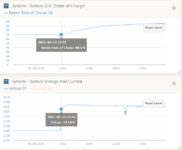Sorry, my mistake. You are right, but as this is generally set at around 13.7v then its as near as makes no difference to the statement I made.
The point I was making is, the first
battery takes priority charge, then any spare is sent to the second
battery.
Sorry, I have to disagree with the idea that the
battery will be "as near as makes no difference" to be fully charged.
Yes, if a
Battery was sitting at around 13.7V and was disconnected from any charging system, it really would be fully charged without a doubt.
But .... a
Battery sitting at around 13.7V whilst attached to a charger is absolutely not close to full.
A little graph to illustrate this ....

Here the
battery bank is below 70% State of Charge. If you take 50% as the base you never want to go below and 100% as full, under 70% would mean you have less than half the
available capacity of the
battery available and nowhere near full.
But check out the voltage of the
battery - 14.18V. Well above the switch-on voltage threshold of a VSR.
I hate to labour the point but the
battery would NOT be even close to fully charged at the point a VSR engages unless it actually started out close to fully charged when the engine was switched on.
Also, a VSR is just a relay, it is not an intelligent device, it is just a electrically activated switch and when it activates, the Starter and the Leisure Batteries are connected together and that is it - there is no concept of 'priority charge' and 'spare charge' with a relay.
The closest to intelligence when it comes to a relay-based charge system is probably the
Victron Cyrix-ct, which monitors voltage levels over time and adjusts the on-threshold voltages based on how long the voltage has been above certain preset values - but even that is just a way to adapt when the relay switches on - when it is on, again it is just a switch that has been connected.
There is so much misinformation on how "split-chargers" operate on the internet, the erronous ones need to be responded to.

